- Bernard Preston homepage
- Beekeeping
- Creamed Clover Honey
Creamed clover honey
Creamed clover honey is really very easy to make in five minutes, in small quantities; say a ten-litre bucket.
You could do it with a wooden-spoon using a little elbow grease, an electric kitchen beater or a hand drill, but I have burned both out when stirring the honey; it is viscous stuff and needs more power. More than your arm will provide too, unless you have only one or two pots.
To do large amounts you need a heavy-duty pedestal drill and a paddle.
Creamed honey like the one on the right is much softer and smoother than that which has simply crystallised, or set as some say; that on the left is from the eucalyptus trees and not clover. It is much darker and obviously still runny.
So how do you turn runny honey that drips everywhere into the creamed stuff on the right? It is easy.
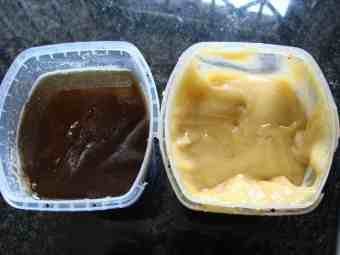
This page was updated on 9th April, 2023.
The difficulty with low density honeys from clover, jacaranda and orange blossom for example is that that they won't set readily. And if you force it by putting them in the refrigerator you may get large, unpleasant crystals.
It all has to do with the ratio of glucose to fructose which varies in every honey. Each kind of flower will produce its own unique nectar with different scents, phytochemicals and colour.
Some will set very quickly, but others not at all. It's a fascinating business for those who love bees and 'keeping. And a lot of deep science if you want to get down to the molecular level.
The glucose is less soluble than the fructose, so when the former is preponderant, then the honey will tend to set.
If there's more fructose, then it will stay runny.
Honey is a supersaturated solution mostly of these two sugars and a large number, literally dozens, of other phytochemicals that give each jar its unique scent and flavour. Plus the bees add certain substances as they secrete it, and regurgitate it up from their stomachs. That sounds gross, but it isn't. We are fearfully and wonderfully made and so are our little friends.
Grasping the meaning of simple vs complex carbohydrate is vital if you want to avoid obesity and diabetes. That means pain; lots of it.
Perhaps back in school science you grew crystals of alum or copper-sulphate from a supersaturated solution. When creaming honey you will use the same principle, only a myriad of tiny seeds; that's what makes it so smooth.
Unfortunately creaming honey is one way that some commercial bottlers will use to deceive you; they warm their honey so that it's easier to work with, but spoiling it in the process. Then when it sets it often will form large unpleasant crystals; that heating would certainly affect these special substances that make the nectar from the gods unique.
So they seed it with a small amount of creamed honey, stir it in, and you will be none the wiser that this is now a processed-food.
Yes, it takes more time but the way our grandparents did it, visiting the farmers' markets and finding a small 'keeper is the road to sparkling well-being; better still keep your own bees, and make your own creamed clover honey, and grow your own kale and lima beans.
Here is a bit of fascinating medical history, not directly related to creamed clover honey but you will soon get the drift. Dr William Castle, the physician who discovered 'intrinsic-factor', vital for the absorption of vitamin B12, without which we would die from pernicious anaemia conducted a bizarre experiment. He swallowed raw beef mince, vomited it up and fed it to ten patients with the disease.
Ten control patients were fed straight beef. The group who ate the vomited-meat recovered from PA, proving the existence of a substance secreted in the stomach without which we cannot absorbe vitamin B12.
In similar fashion, bees secrete a myriad of substances in their 'honey stomachs' from which we can benefit. Current research is focusing on glucose oxidase that produces hydrogen peroxide, methylglyoxal and defensin-1 which give honey its anti-microbial properties[1].
But to get back to your creamed clover honey; if you want it solid so that it will not run off the toast and drip down to your elbows like watermelon-juice then the trick is to process it yourself.
First go out and buy a couple of bottles of high quality raw-honey. It's all a bit messy so you might as well do a few jars at a time.
Then purchase a bottle of creamed raw honey; not the heated stuff that the commercial bottlers use. This you need do only once, so get the very best you can find; it will be expensive.
From here on you will use your own creamed honey to seed the next set of jars.
Pour say three bottles of your liquid clover honey, or orange-blossom, or whatever, into a bowl; now add about 10% of that creamed stuff that you've just bought. It is really not critical how much exactly.
And then use one of the mixers that came with your electric kitchen appliance, on the lowest setting, or a wooden spoon, to blend that creamed honey into the liquid stuff; just a few minutes. Pour it back into the bottles and put it on the shelf.
Within a week you'll have your beautiful soft-set honey.
Delayed mowing of our lawn has greatly helped our creamed honey crop; it's been invaded by clover.
Creamed clover honey
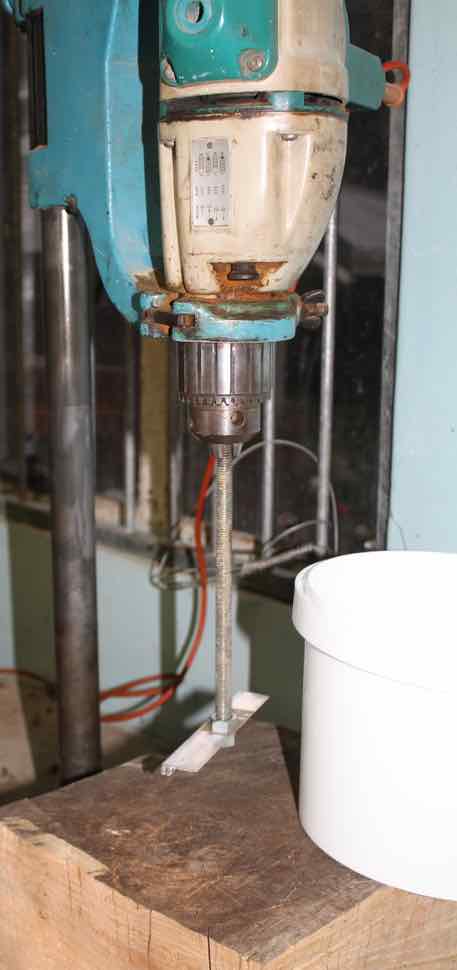
Creamed clover honey or any other for that matter just requires some seeding material and a drill-press if you want to do it in larger quantities.
When you've burned out a few kitchen electric-mixers, then give thought to doing this on a larger scale with a more powerful machine.
Whilst I'm not expecting many homes to have a large and powerful drill-press like this one, if you are moving into the commercial realm then you will certainly need a machine that can produce a good turnover without overheating.
I can do 150-pounds in a couple of hours, so this drill has paid for itself; you can't do this with a small kitchen or garage appliance.
Newsletter
Our newsletter is entitled "create a cyan zone" at your home, preserving both yourself and Mother Earth for future generations; and the family too, of course. We promise not to spam you with daily emails promoting various products. You may get an occasional nudge to buy one of my books.
Here are the back issues.
- Lifestyle and ideal body weight
- What are ultra-processed foods?
- Investing in long-term health
- Diseases from plastic exposure
- Intensive lifestyle management for obesity has limited value
- A world largely devoid of Parkinson's Disease
- The impact of friendly bacteria in the tum on the prevention of cancer
- There's a hole in the bucket
- Everyone is talking about weight loss drugs
- Pull the sweet tooth
- If you suffer from heartburn plant a susu
- Refined maize meal and stunting
- Should agriculture and industry get priority for water and electricity?
- Nature is calling
- Mill your own flour
- Bake your own sourdough bread
- Microplastics from our water
- Alternative types of water storage
- Wear your clothes out
- Comfort foods
- Create a bee-friendly environment
- Go to bed slightly hungry
- Keep bees
- Blue zone folk are religious
- Reduce plastic waste
- Family is important
- What can go in compost?
- Grow broad beans for longevity
- Harvest and store sunshine
- Blue zone exercise
- Harvest and store your rainwater
- Create a cyan zone at your home
I made a simple paddle out of a length of threaded-rod, two nuts and a piece of aluminium conduit that I twisted slightly to increase the beating effect. Make sure there's at least 30mm between the end of the blade and the sides of the bucket; 60 millimetres less than the diameter when making your creamed clover honey.
Add roughly 2TBSP of creamed honey from your stock to about ten litres in a large plastic bucket; and then beat it for a few minutes.
If you want to incorporate a lot of air into the mixture, making it lighter still then you will need to beat it for much longer; I couldn't be bothered but you will get a better return because you are now selling air at a premium.
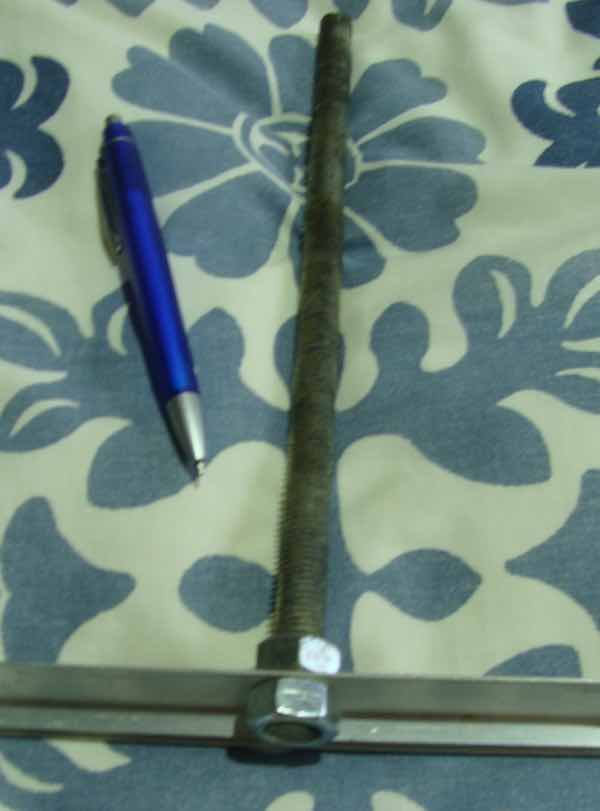
Pour your raw honey into the bucket, add the seed and beat for three or four-minutes, just to distribute it through the liquid.
Some of our best honey comes in when trees from our citrus fruit list are in flower. The tantalizing hint of phytochemicals like limonin that makes it so special comes through.
It's in limes and lemons too.
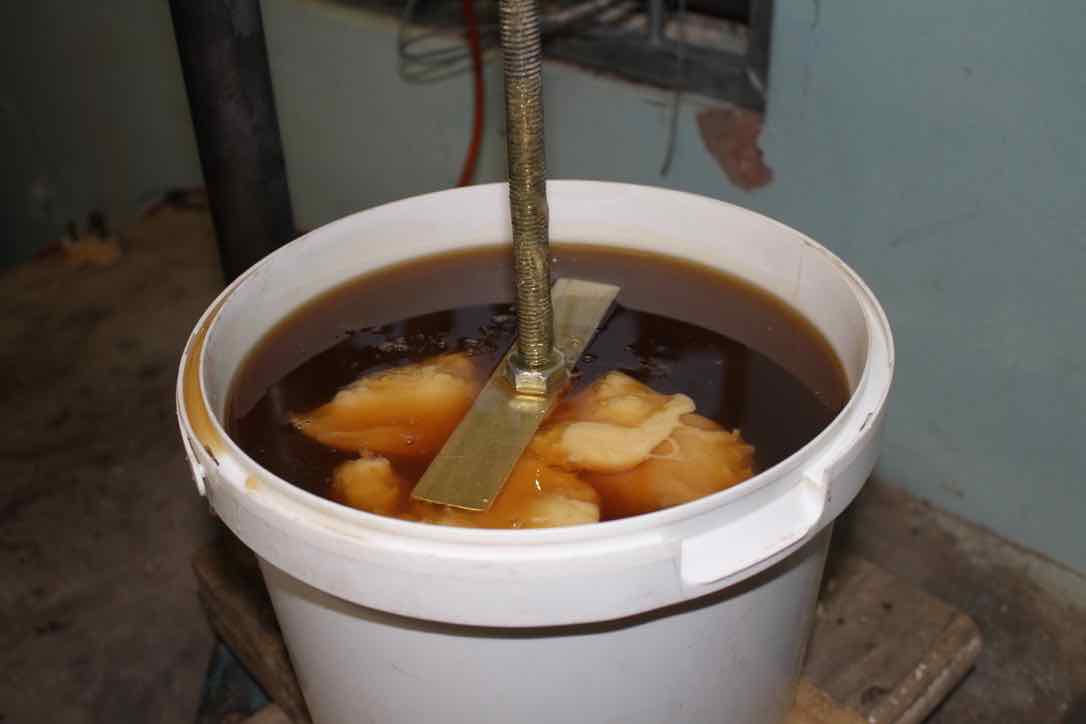
I now use a wooden frame to support the bucket; cut with a band saw.
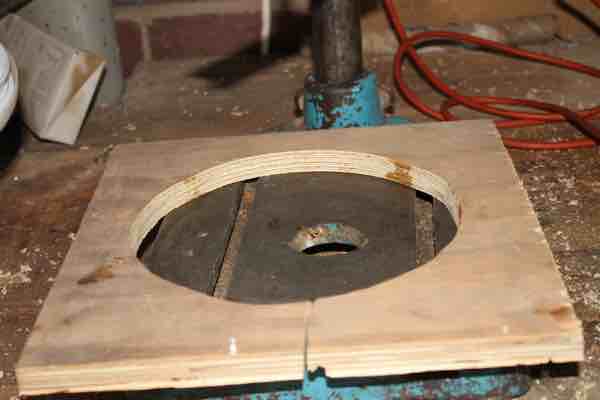
Holding the bracket instead of the bucket gives you far better control as the paddle is lowered into the honey; should it move out of position it would be shredded and possibly your hand too.
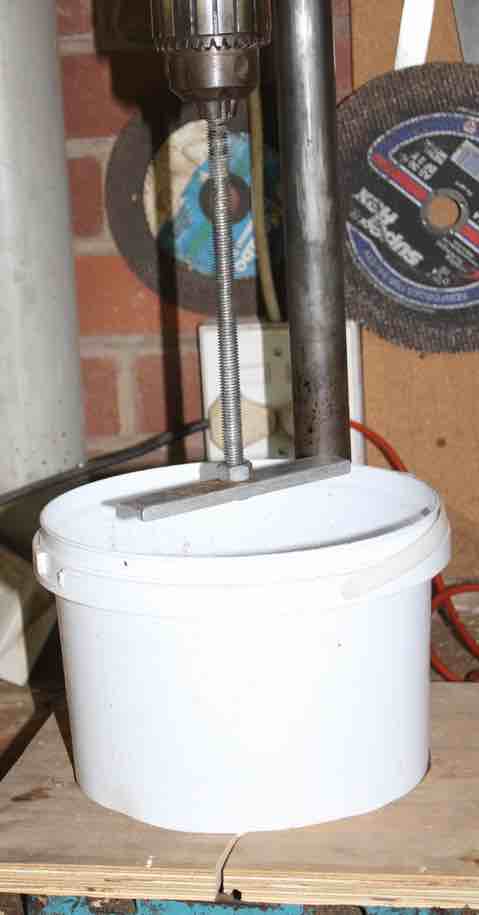
These were both bottled yesterday, the one on the right obviously the creamed honey. I can detect no difference in taste but that on the left will set rock-hard The other remains soft with a consistency like that of peanut butter.
I will try and remember to add photos of these same two bottles in a month's time.
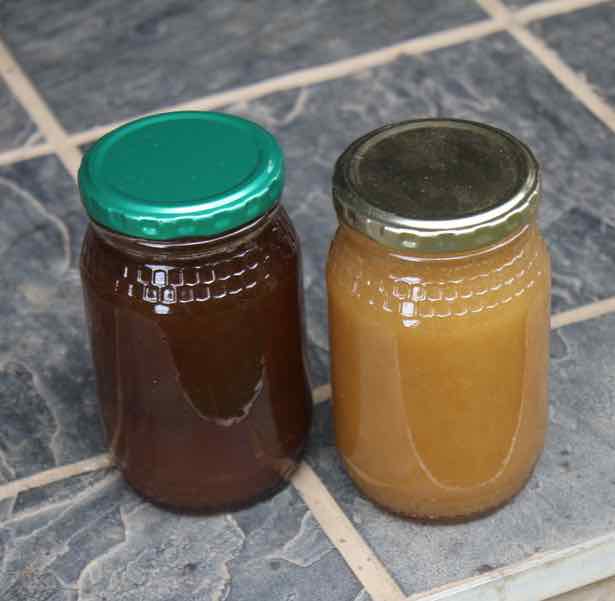
Notice below how the regular runny honey on the left has set rock hard and crystallised, whilst that on the right remains soft and is easy to spread.
It's exactly the same honey but has different physical properties.
Which would you buy if you saw both on the shelf in the shop? I'll bet the one on the left but that on the right is far better.
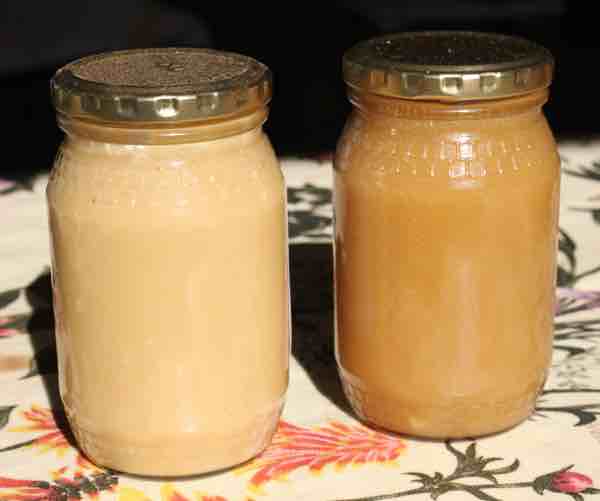
It's really just a matter of personal taste. I refuse to heat either because of the unseen spoilage of our very special and virtually unique raw honey.
Creamed clover honey or any other like this from the eucalyptus tree, is to my mind just more user-friendly.
Oxygen
When you expose any food to oxygen, it begins to decay; that is why we are going to have a very difficult time weaning ourselves off plastic. As far as our creamed clover honey is concerned, we whip it very briefly, just to distribute the find crystals throughout the bulk; little air is blended into the mixture.
However some processors will cream the honey for an hour or more, incorporating a lot of air into the mixture; it becomes light and fluffy, weighs considerably less than a pound making it more expensive but more importantly exposing it to oxygen. I don't recommend it.
Our three-minute creamed clover honey is quite soft and creamy enough.
Useful link
When browsing use right click and "Open Link in New Tab" or you may get a bad gateway signal.
Did you find this page interesting? How about forwarding it to a friendly book or food junkie? Better still, a social media tick would help.
- Bernard Preston homepage
- Beekeeping
- Creamed Clover Honey
Address:
56 Groenekloof Rd,
Hilton, KZN
South Africa
Website:
https://www.bernard-preston.com